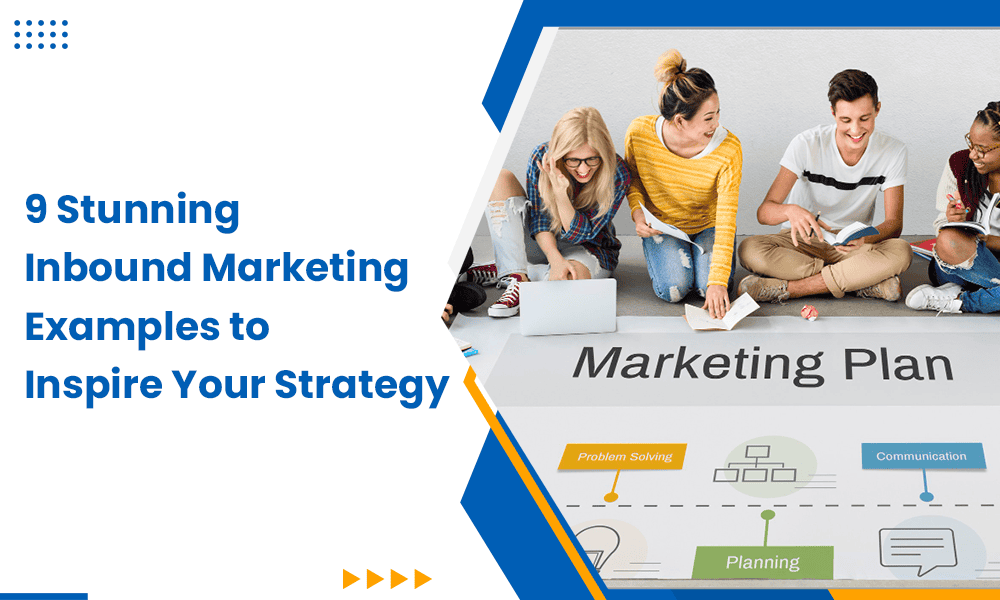Let’s imagine for a second that your company attracts loyal customers to your brand based on the value you provide with your content and high-quality products. Gone are the days of pushing advertisements, interrupting customer schedules with cold calls, and blowing big money on ads.
What if we told you this is precisely what a successful inbound marketing strategy can do for your company?
An effective inbound strategy is where your company sustainably creates high-quality content across channels to boost organic customer engagement and loyalty. It enables them to glean value at any stage of the customer lifecycle.
All your competitors are already doing it, so don’t be late to the bandwagon! This blog post outlines a step-by-step guide to creating and implementing an effective inbound strategy.
It includes some stunning examples and success stories you can use for inspiration, the methodology, its core components, and tips on seamlessly implementing them in your small business.
Ready to get started? Let’s go!
Table of Contents
Key Takeaways
- The key elements of a successful inbound marketing strategy include three main stages: attract, engage, and delight.
- In the “attract” stage, creating effective buyer personas can elevate your strategy. The goal is to attract strangers to your website or blog through quality content. Buyer personas help you hone in on the right kind of customers and predict future behavior.
- In the “engage” stage, the goal is to convert prospects into customers. An effective CTA (Call-to-action) or downloadable materials like ebooks and whitepapers can prove effective.
- Finally, in the “delight” stage, the goal is to retain and engage customers who are already interested in your products or services. Here, email and behavioral personalization can do wonders.
- The core components of a successful inbound marketing strategy include content marketing, SEO, social media marketing, email marketing, lead nurturing, analytics, and measurement.
- Once you implement your inbound marketing strategy that is well-aligned with your overall marketing and business goals, you can expect to see long-term benefits in a few months.
- Maintaining content quality and consistency becomes key to ensuring the long-term benefits of inbound marketing.
The Inbound Marketing Methodology
To improve the quality of your leads and make it easier for your sales team to close more leads, then inbound marketing is the way to go. Lately, there’s been a marked increase in companies that prefer to use inbound marketing strategies over traditional outbound marketing methods.
A recent survey found that as far back as 2018, 74% of organizations relied on inbound marketing strategies for lead generation and customer engagement. Another 2022 survey found that inbound marketing can boost lead generation by up to 10x when executed correctly and double the conversion rates!
But, a word of warning. Not all inbound marketing strategies are created equal. So, before you dive in, you must understand the basic methodology behind inbound marketing.
Traditionally, inbound marketing strategies divided the pipeline into four stages: attract, convert, close, and delight. Sounds simple.
However, as customers become more tech-savvy and prefer to do their research, companies have quickly adapted new methodologies to provide a better overall customer experience.
A new methodology of a flywheel has now become a standard inbound marketing methodology. Here, we have three crucial phases instead of four.
They are:
- Attract (strangers)
- Engage (prospects)
- Delight (customers)
How you cater to prospects at each stage forms the cornerstone of a successful inbound marketing strategy. Let’s dive a little deeper into each stage. Feel free to skip this section if you’re already familiar with it.
Attract (Strangers)
While the concept seems simple, there is more to this stage than merely optimizing your content with SEO or keywords and having a great content calendar. After all, you want quality prospects, not just anybody.

Before finalizing your content strategy, identify your target audience and ideal customers. Here, creating strategic, data-driven buyer personas will save the day. This is a fictional avatar you can make for your ideal customers. Each buyer persona will be a stand-in for a segment of your audience.
This will help you understand customer behavior and predict future behavior.
Only then will your strategies for the “Attract” stage remain effective over time. Once you create your authoritative content, it will generate quality leads and keep your SERP rankings high.
Engage (Prospects)
Once you attract quality leads to your website using quality content, the next logical step is to convert them into long-term, loyal customers. That’s what this stage focuses on.

Here, the goal is to keep the prospects engaged and provide enough value to be prompted to give you information in return. This could include their email, preferred communication channels, demographics, and content preferences.
Call-to-action (CTA) buttons, forms, and lead flows can boost conversion rates. You can also use downloadables like an ebook, whitepapers, subscriber-only content, or a demo request instead of a simple CTA.
Delight (Customers)
The delight stage is where customers are already engaged with your content. Here, the goal is to continually engage and delight them by providing value, offers, and curated content to match their niche interests.

At this stage, personalization is your best friend. This ensures the right messages reach target customers at the right time. Also, it’s a great chance to troubleshoot customer pain points and provide solutions to retain their loyalty and interest in your products.
But how do you successfully meet these goals for each stage of the inbound marketing framework? It’s not rocket science; we’re here to guide you through it all. Let’s look at the core components you need to get right.
Core Components of Inbound Marketing
Whether it’s curating exciting articles for your blogs or running analytics on blog performance, there are crucial components of inbound marketing you can’t afford to ignore. We suggest that you take each one seriously for the best results.
Content Marketing
An inbound marketing strategy without the right content marketing is merely an empty promise. And, when your content marketing strategies aren’t aligned with your larger inbound marketing goals, you’ll have increased engagement without significant conversions.
Your content marketing strategy should ideally serve you well in all three or four stages of the inbound marketing framework. In a world where “publish or perish” is the motto, your content marketing strategy should be flexible and grounded.

Your content should include long and short-form blogs, emails, infographics, videos, podcasts, and social media posts.
For the “convert” stage, your content marketing strategy can shine through by providing excellent whitepapers, case studies, webinars, product demos, comparison guides, and free trials in exchange for customer details. This allows prospects to make informed decisions and remain loyal.
At the “delight” stage, providing engaging content across channels is the main priority. This includes personalized email and social media campaigns, tutorials, user-generated content, testimonials, and personalized offers to provide an excellent post-purchase experience for each customer.
Search Engine Optimization (SEO)
The next crucial component is Search Engine Optimization (SEO). Why? Optimization helps increase your visibility and views in search engine results pages (SERPs) whenever a user searches for relevant keywords and phrases. It helps your target audience find you.

So, the crucial aspect of this component is understanding the language of your target audience at the “attract stage.” This ensures that the language of your blogs, CTA buttons, and landing pages align perfectly with what your target audience is actively searching for.
In the “convert” stage, SEO can help you create curated content to solve specific customer pain points. You can then map your content to highlight how your products can effectively solve these points.
Finally, you can continue to engage customers in the final stage by providing valuable and delightful content to boost customer loyalty.
Social media marketing
Today, over 77% of US citizens have a profile on a social media channel, and there are an estimated 3.4 billion social media users worldwide. So, it’s a no-brainer that social media marketing forms an important element of your overall inbound marketing strategy.

Social media channels can be leveraged for any stage of the inbound marketing methodology. Whether it is generating leads, improving brand awareness, keeping customers engaged through useful posts and videos, or releasing user-generated content and testimonials — social media channels can help you do all this and more.
A few well-placed paid promotions can help close more deals on a slow month. Collaborating with influencers in your niche is a sure-shot way to gain a few quality leads by tapping into their audience base. When prospects see loyal customers engage and interact with your content, it builds social proof and brand credibility.
Social media channels like LinkedIn or Instagram also provide useful analytics and statistics to help you hone in on the right audience and boost your reach in the long run!
Email marketing
Email marketing is a crucial component of your inbound marketing strategy. It ensures that the right content is delivered directly to the prospect’s inbox. Of course, email marketing can be used effectively for both inbound and outbound marketing.
Outbound marketing emails usually include cold emails and direct emails. But, inbound email marketing tends to be more targeted and personalized and provides value to the customer or prospect.
For instance, a monthly newsletter email can effectively engage customers with behind-the-scenes content from your company and highlight new product features and special discounts.
Adding a few of your curated, top-performing blogs and personalizing them based on customer segments is another way to increase engagement. Email marketing can also help re-engage inactive customers with a well-timed and attractive email campaign.
Read more: How Email Marketing Can Fuel Your Overall Inbound Marketing Strategy
Lead nurturing
Inbound lead nurturing is the process of taking effective steps to move prospects through the sales funnel and convert them to loyal customers. On average, a prospect will interact with your brand up to 8 times before they are ready to convert.
This is one of the components most companies, regardless of their size, struggle with. So, for an effective inbound lead nurturing strategy, you need to be able to convince and engage with prospects at multiple touchpoints.
Successful lead nurturing campaigns can take an omnichannel approach to guide and encourage prospects by interacting with them, addressing their concerns, and solving their pain points efficiently.
So, in addition to emails, you engage them with social media posts, explainer videos, whitepapers, case studies, and even interactive calculators if they apply to your niche. All these strategies of inbound lead nurturing help your company stay top-of-mind for prospects who will purchase from you in the future.
You must follow up with leads across touchpoints on time to ensure the best results. Use A/B tests based on your lead intelligence data to determine the most effective frequency for each segment.
Analytics and measurement
You have incorporated most of the components for effective inbound marketing. However, you must measure its effectiveness and implement timely changes.

This is where analytics comes in. It helps you understand user behavior by tracking KPIs (Key Performance Indicators) like website traffic, engagement, and conversion rates.
You’ll need an analytics tool like EngageBay’s CRM to streamline data from different channels and touchpoints to track the conversion path, from the first interaction to the purchase. With the right KPIs and tools, you’ll also be able to make data-driven decisions and track future trends.
Here are our top four KPIs that companies must measure.
- Conversion rate: This KPI measures the percentage of customers who took a particular desired action or a set of actions like signing up for your emails or purchasing your product.
- Website traffic: This indicates the overall effectiveness and brand visibility of the inbound marketing strategy. It helps assess the quality of your content and SEO strategy. You can track metrics like total visits, unique visits, and page views to get a comprehensive picture.
- Lead generation and conversion cost: By tracking metrics like the cost per lead (CPL) and cost per acquisition (CPA), you can assess how much you’ve spent on each lead and allocate resources more effectively.
- Engagement metrics: Metrics like bounce rates, pages per session, social media engagement, and time on site can help you measure your success in retaining customers’ interest.
Think of each component as one layer of the cake: your inbound marketing strategy. Get it right, and you have a delectable one that prospects cannot resist!
9 Inbound Marketing Examples and Success Stories
Here are some inspiring inbound marketing examples and success stories you can use to boost your own inbound strategy.
1. Whitepaper from ADP
ADP is now an important player in cloud-based Human Resources Management and Business Process Outsourcing (BPO). The company handles payrolls for around one-fifth of all individuals employed in the USA.
When ADP wanted to reach out to small businesses, they launched a lucrative and handy white paper titled “Smart Small Business Payroll.”
This was an incredibly effective whitepaper. It laid out the key pain points of small businesses in the US when it comes to handling their payroll strategies.
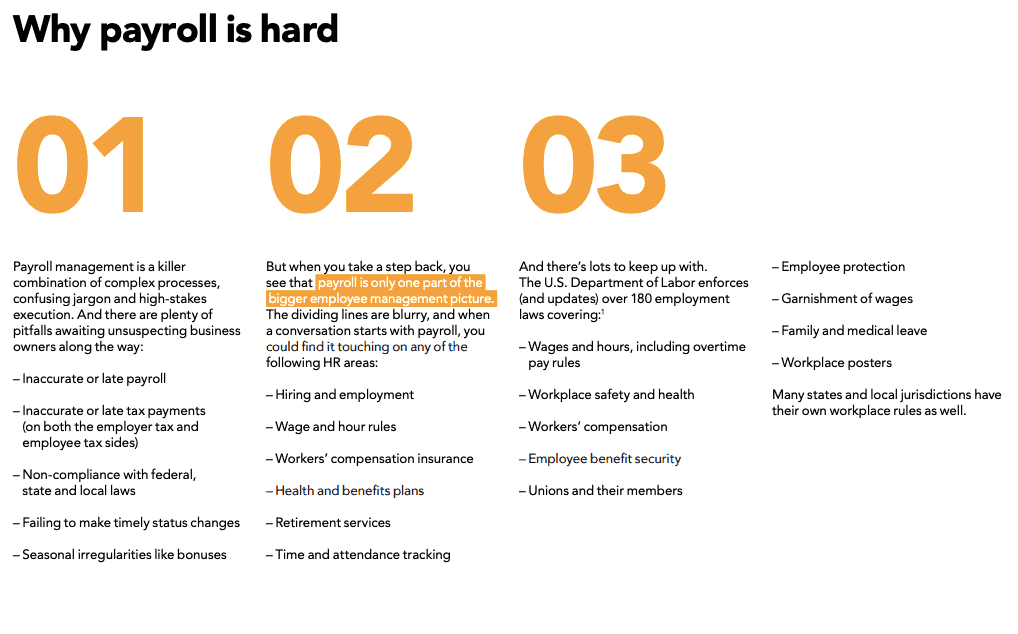
The whitepaper then gives suggestions for improvement and outlines a step-by-step process to leverage ADP’s insights to migrate to an effective payroll system. They simultaneously launched a new app to help small businesses outsource their payroll systems.
The excellent design, the actionable insights of the whitepaper, and the option to migrate to ADP for small businesses made this effective.
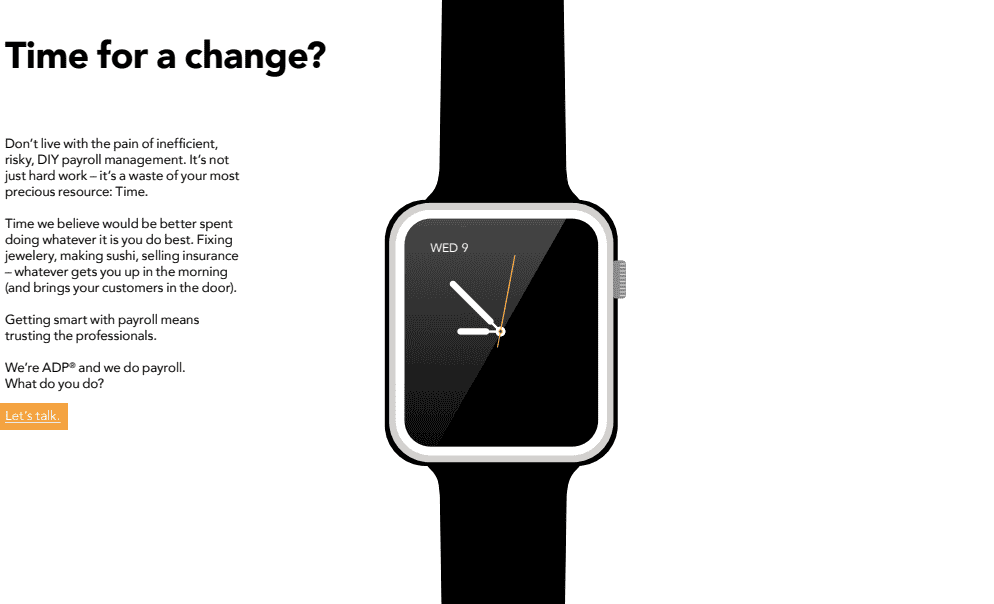
2. Neil Patel’s blogs
Neil Patel is one of the most popular names in marketing. What makes his blogs stand out from the rest?
Well, one of the basic factors is the value addition provided by his content. It’s a wonderful example of leveraging one’s strengths and expertise to create credibility and deliver value with each blog.
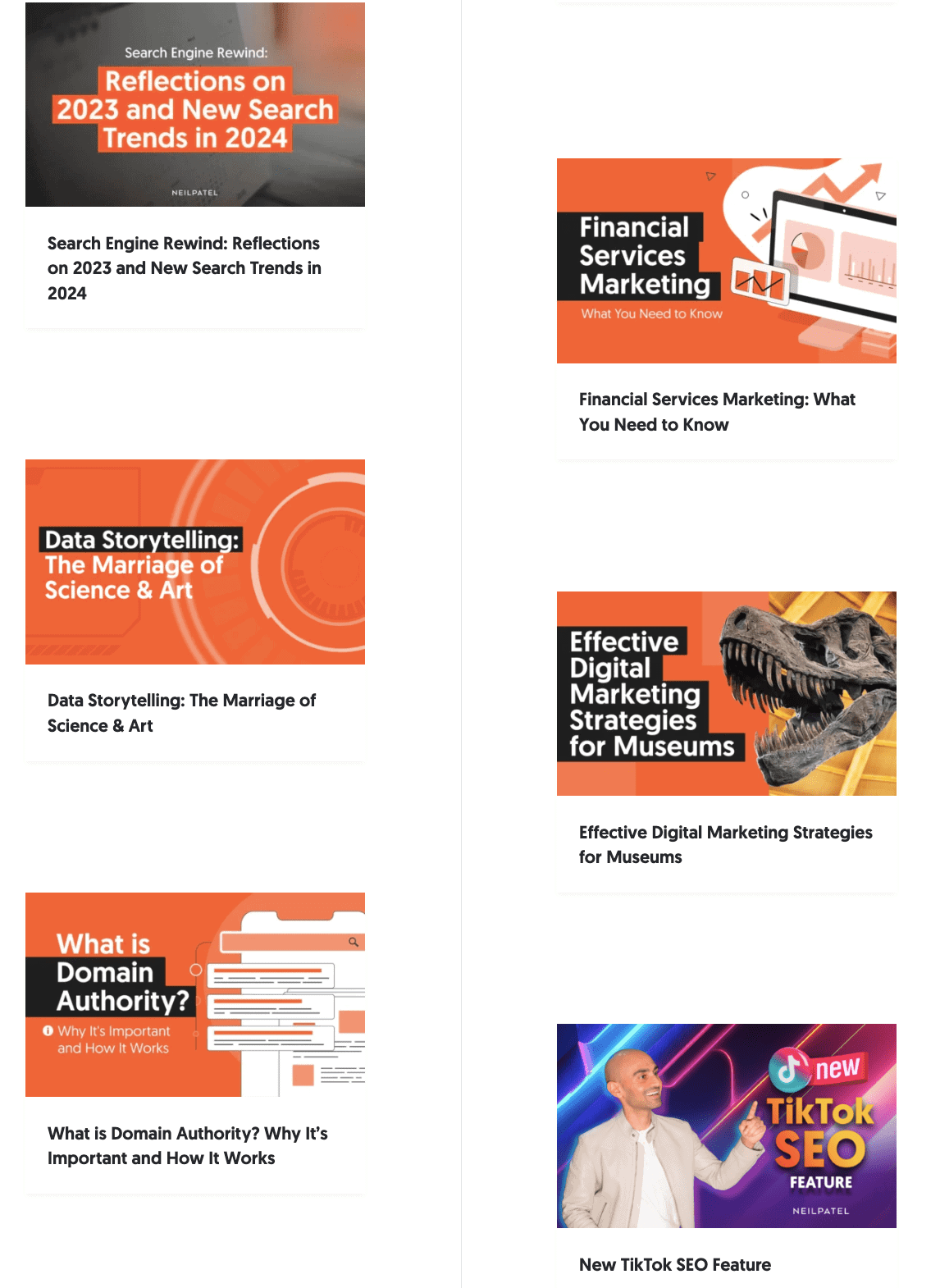
Neil states that the digital marketing landscape hadn’t evolved as much when he started his blog. There wasn’t as much emphasis on social channels or YouTube as today. His grounding principle of offering quality content, his SEO, and his backlinking strategies generated demand for his blogs.
Although he has a strong team behind him, Neil ensures he adds a personal touch to all his blogs. Also, he streamlines his content with a clear publication and content schedule in place. His blog’s awesome call-to-Action (CTA) is another thing to learn from.
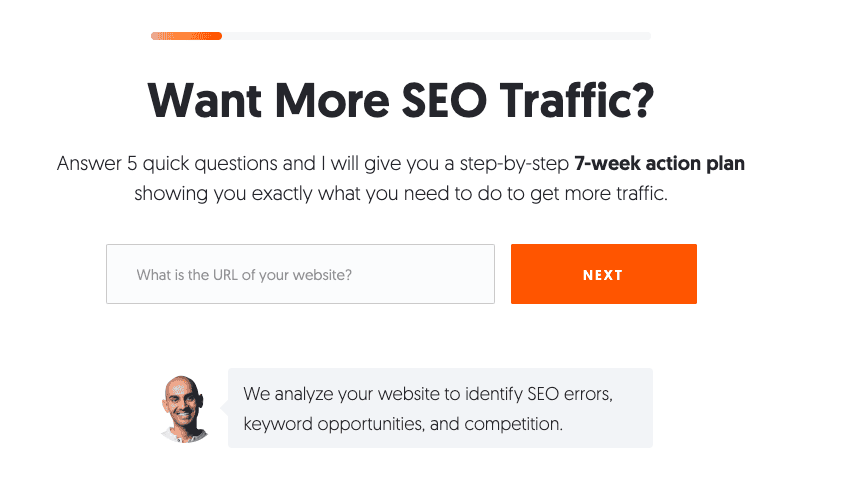
3. HubSpot’s use of infographics
HubSpot is known for its excellent content distribution and strategy. However, one aspect of their marketing strategy that stands out is their infographics.
Once they successfully leveraged infographics in their own company, HubSpot offers free infographic templates that prospects can download. This also serves as a lead magnet for them.
What’s more, they were able to help other brands like SeikoVision build effective infographics for their landing pages and blogs. Here’s an example.
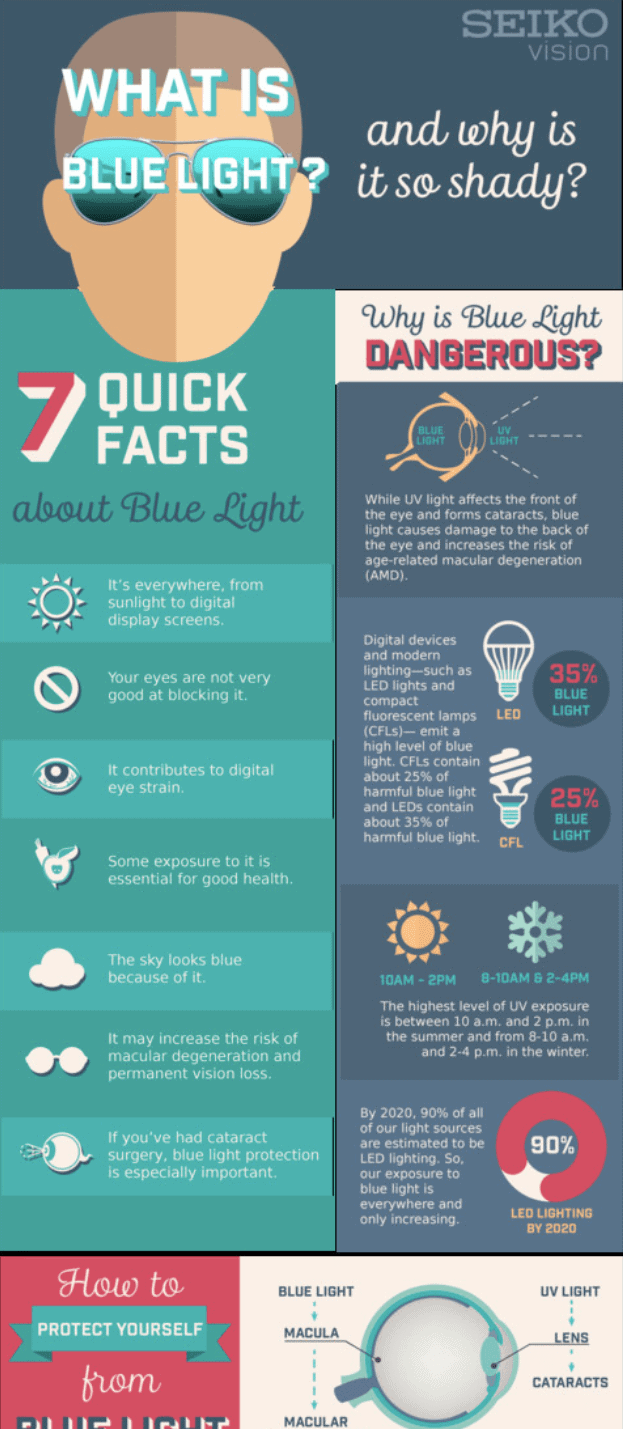
With the right supporting content for this infographic, SeikoVision generated 571 new views within just two weeks, which had a conversion rate of 26.22%! By the end of the campaign, they boosted MQLs by a whopping 945%.
Remember, they also used other strategies like paid ads and email marketing to get the final result. The strategic use of infographics with HubSpot is a commendable feat that contributed to the final result.
4. Seramin’s SEO strategy
Seramin was launched in 2004 as an HR outsourcing company in South Korea. Since then, it has expanded into one of the largest recruiting companies in the country.
Seramin’s clients depend on it for job recommendations and AI-powered interview preparation solutions that distinguish it from similar firms.
In 2015, they faced a unique challenge of making their website more searchable and showing up higher on the SERPs (Search Engine Results Page). They wanted to ensure that the Googlebot was crawling their website for proper indexing and fixing crawling errors.
Here’s what they did:
- The Seramin team invested in SEO and first removed meta tags that were cluttered and outdated with unnecessary keywords.
- They then used canonical keywords and further streamlined their content to reduce redundant content.
- They dealt with errors in their structured data by checking their URLs with the Google Structured Data Testing Tool.
- The team improved user experience by testing their landing pages for mobile optimization, speed tests, and AMP tests.
As a result, they saw a whopping 102% increase in their year-on-year traffic from organic Google searches by 2019.
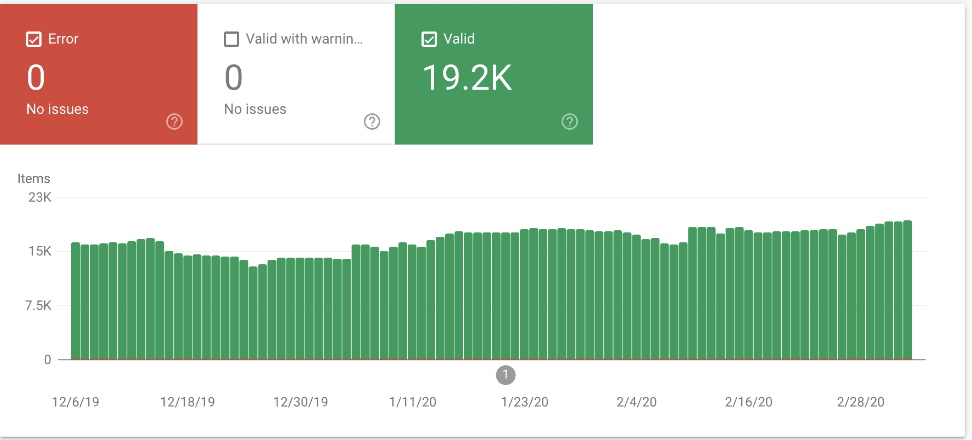
They also saw a 9% increase in year-on-year conversions and a sharp rise in mobile usability.

5. Spotify Wrapped social media success with user-generated content (UGC)
If you’re unfamiliar with Spotify Wrapped, then you might be out of the loop. Since its launch, Spotify downloads increased by 20% back in 2020. Users have shared their Spotify Wrapped stats over 100 million times in 2022 alone!
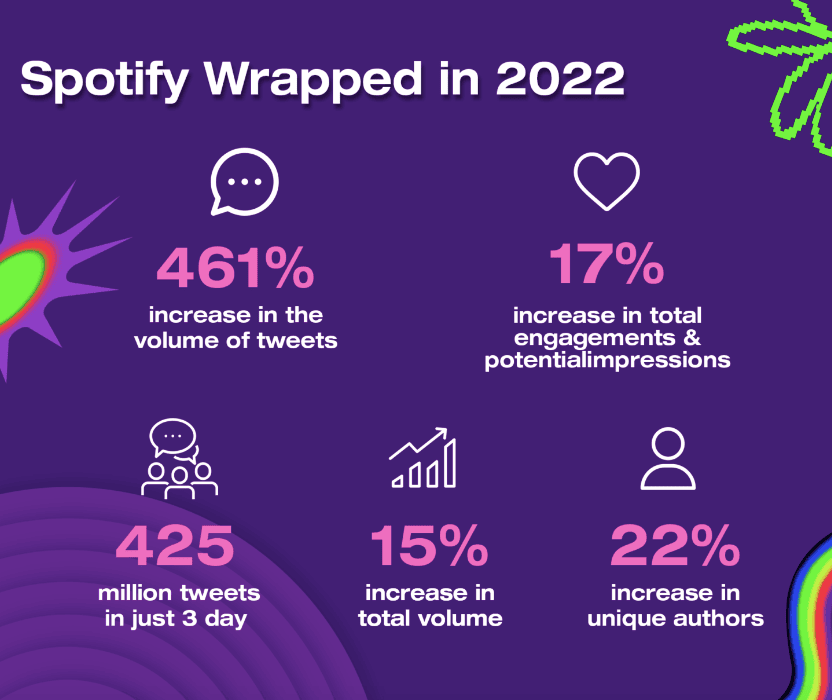
Now, it wasn’t exactly easy for Spotify to launch this successful marketing campaign, given the vast amount of data. Spotify collected vast amounts of data to create insights into behavioral data like favorite artists and metadata about listening habits and how they changed throughout the year.
Once this data was hosted in a single repository, their team gathered vast amounts of data to combine millions of events and aggregate them for each user.
However, Spotify stands out in translating this data into compelling, engaging stories that resonate emotionally with the audience. This way, Spotify Wrapped improves brand loyalty and generates a sense of FOMO.

6. Wendy’s social media engagement strategy
Wendy’s is a fast food chain that needs no special introduction. But people don’t just follow Wendy’s on social media for nothing.
While you may get deceived by their logo with the girl in cute pigtails, their replies are as savage as hilarious!
Wendy’s owes its social media success to effectively leveraging pop culture trends and meme culture to keep prospects and old customers hooked. They’re known to hash it out with their top competitors on X. We are all here with popcorn to watch the food wars begin! 😂

Apart from the usual channels like X, Instagram, Facebook, TikTok, and YouTube, Wendy’s also runs a Discord server and a Twitch account that has proved hugely successful with the audience.
They stand out by regularly talking to their audience with witty comebacks and jokes. Here’s a hilarious example.

Our key takeaway is that a large audience will respond to your social channels if you consistently deliver witty and relevant content. So give it a shot and watch the magic unfold, even if you are a small business.
7. Compass Coffee’s segmentation and review incentive success
Compass Coffee is a brand started by two retired marines who got tired of sipping terrible coffee during their posting. Founded in 2014, it has won several awards for its coffee and remains one of the fastest-growing brands.

They launched a special subscription service as the pandemic hit sales targets in 2020. But there was one catch — they needed more reviews to get their subscription service off the ground.
To this end, the brand wanted to incentivize picture reviews from customers. First, they created an effective strategy by segmenting and automating their email list, which helped them identify customers who are likely to leave reviews.
Then, they announced a 15% discount on the next order if a review contained images. Those who submitted a review without pictures simply got a thank you email with a reminder to add images the next time for a discount.
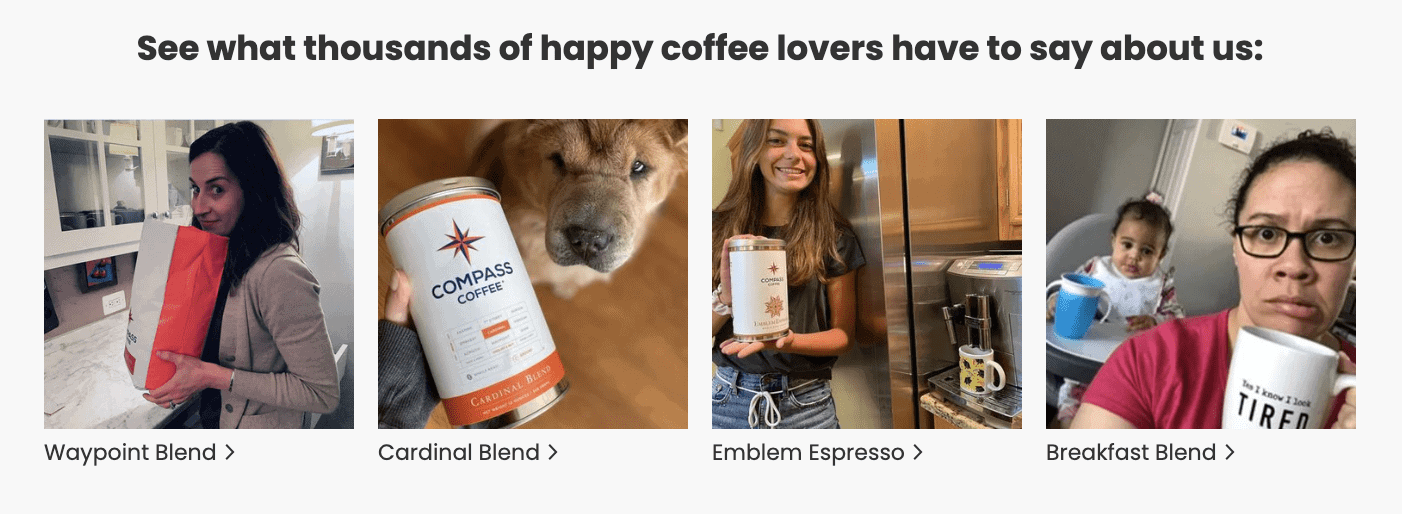
These reviews and images perfectly correspond to their key selling point — your coffee in your kitchen.
The strategy worked wonders: They saw a 3.7x rise in picture reviews and an overall 70% increase in the total number of reviews!

Read more: Inbound Marketing Automation Guide
8. A+ Tutoring’s CRM Strategy Success
A+ Test Prep and Tutoring is a brand that has mentored and taught students for over thirty years and counting. It is known for its expert tutors and excellent course content.
However, a few years ago, they faced a pressing issue with their CRM strategy: using different software for each aspect made the process complex and expensive. They used various popular tools for lead generation, appointment scheduling and tracking, website analytics, email segmentation, sales pipeline management, and analytics.
By switching to EngageBay’s all-in-one platform, they were able to streamline the process. What’s more — they could get all this done from one dashboard.
With the new CRM strategies suggested by the EngageBay team, they could effectively fine-tune all these areas.
We’ll let the results talk:
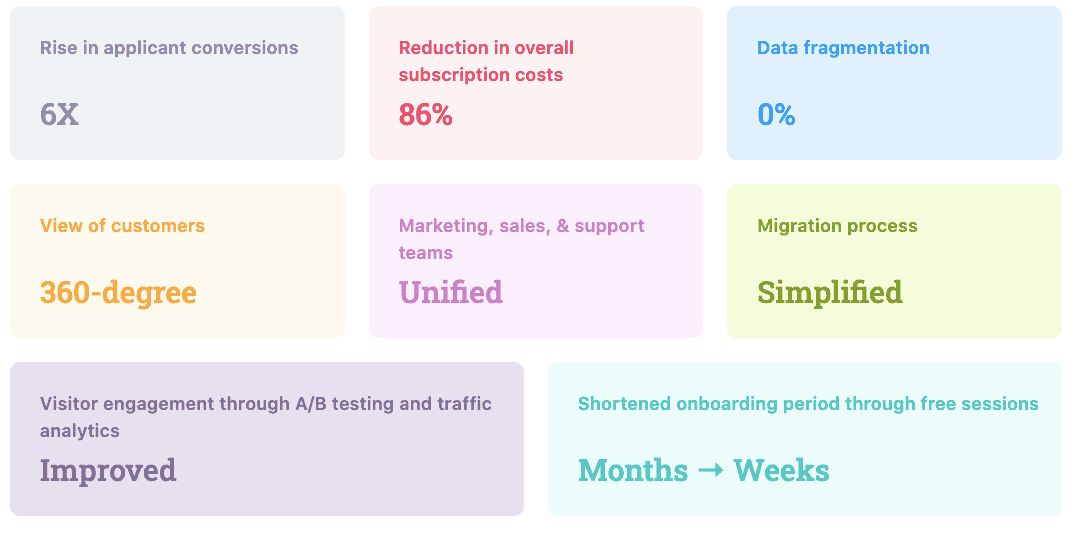
9. Emirates’ Customer Journey Mapping
The poets were spot on when they said, “People may forget what you said, but they will never forget how you made them feel.”
This captures the essence of a successful customer journey mapping strategy, where each touchpoint of customer interaction with the company is mapped out. Then, you identify the opportunities and pain points to make their experience of buying your products or services unforgettable.
One such success story comes from Emirates Airlines, known for its seamless customer experience from start to finish. Here’s the customer journey map.
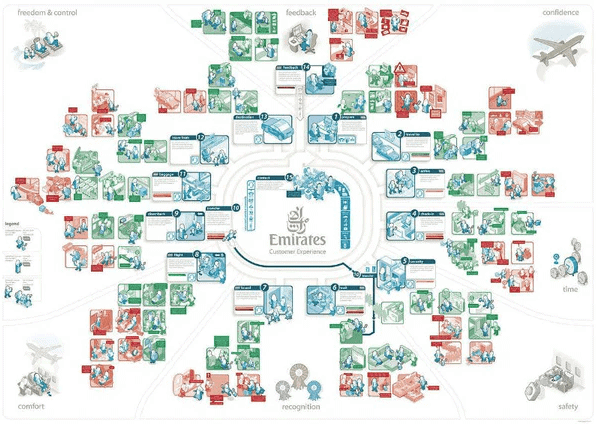
By creating a robust 360-degree view of the customer journey map, they could identify key opportunities and pain points at each journey stage and leverage them to their benefit.
Here are some key aspects of their customer journey mapping success for you to draw inspiration from:
- Excellent customer service at each touchpoint. Whether this is booking tickets on the app to limousine pickups or a layover, they’ve got it all covered.
- Focus on creating memories with the friendly crew at each touchpoint rather than a simple transactional relationship.
- Consistency in the delivery of services at each touchpoint and quick resolution of issues like baggage delays, etc.
- Effective incorporation of customer feedback to improve their customer journey mapping process.
Are you feeling inspired yet? It’s never too late to begin implementing an effective inbound marketing strategy. Remember, getting started is possibly the toughest part, it will surely get smoother with time.
5 Simple Steps to Create and Implement Your Inbound Marketing Strategy
Here’s a handy step-by-step guide to creating your inbound marketing strategy.
1. Set clear goals and create buyer personas for your target audience
The first step is straightforward. Without a goal, nobody can create a roadmap. So, we suggest creating SMART goals for your inbound marketing strategy.
Here, you can set specific goals, like “Increase click-through rate for your emails by 5% in the current quarter.” Here’s a breakdown of the SMART goal method.
We’ve broken down each stage in this segment for your convenience.
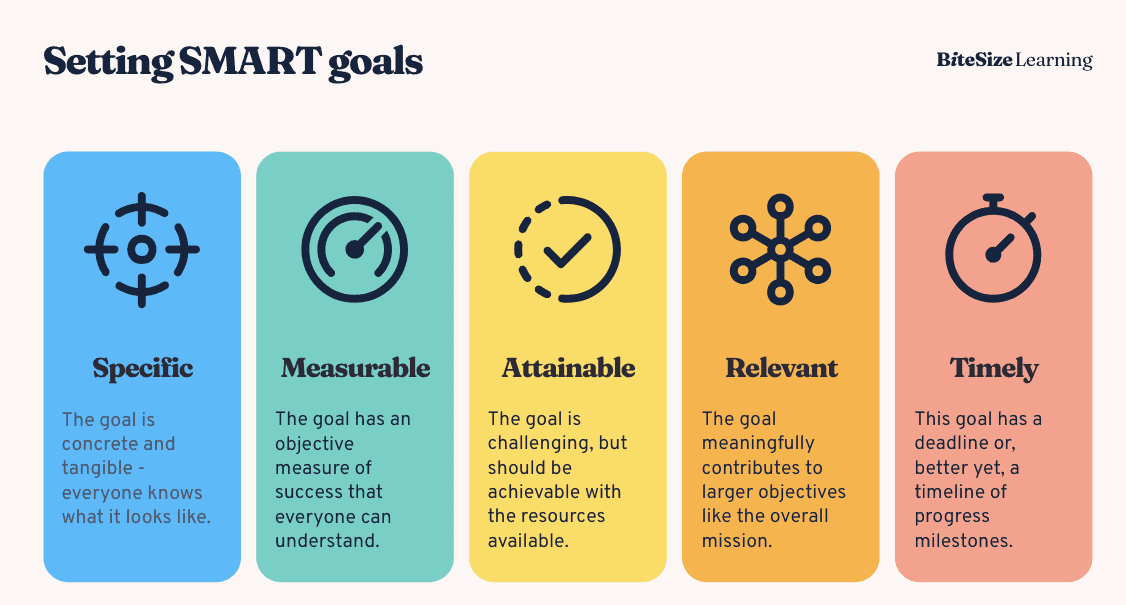
Then, you’ll need to create the right buyer personas. These are profiles of your ideal customers based on your market research and the kind of products and services you offer. Here’s an example for B2B companies.
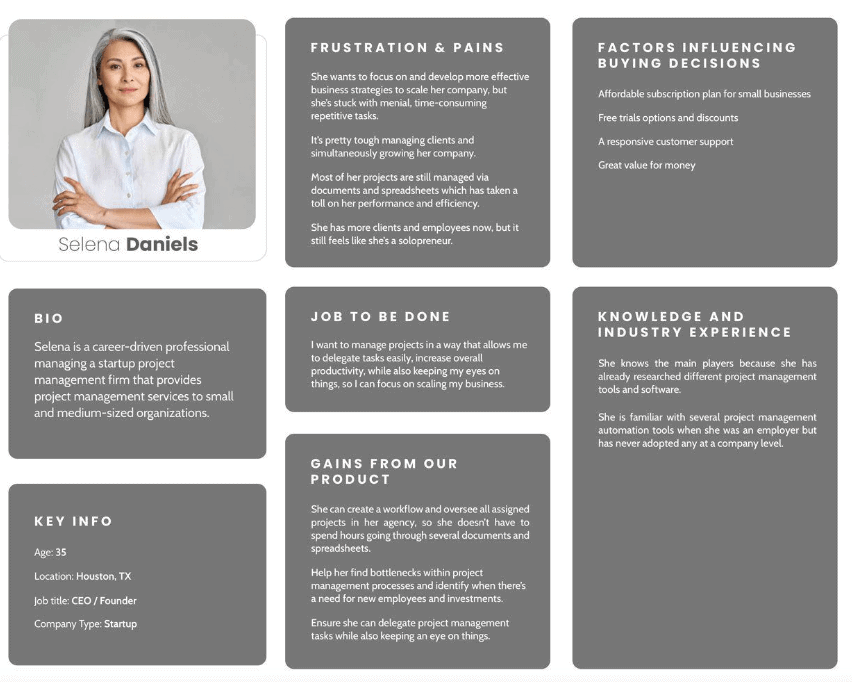
Some common elements of a good buyer persona include:
- Demographics
- Personality profile
- Role and Job title
- Interests
- Barriers to purchase
- Purchase factors likely to be considered
- Goals and motivations
- Information sources and media consumption habits
2. Chalk out possible innovations
Here, take stock of all your content assets first — be it blogs, white papers, website content, social media content, or video content. You need to get a clear sense of the strengths and weaknesses of your existing content.
Conduct a similar inventory of the current marketing tactics being used by your team. How are social channels performing? Are your email marketing tactics effective enough? Ask these questions keeping your overall goals in mind.
Once this is done, consider possible innovations at this stage. Check-in with your sales team and other stakeholders to ensure your innovations are aligned with your overall goals.
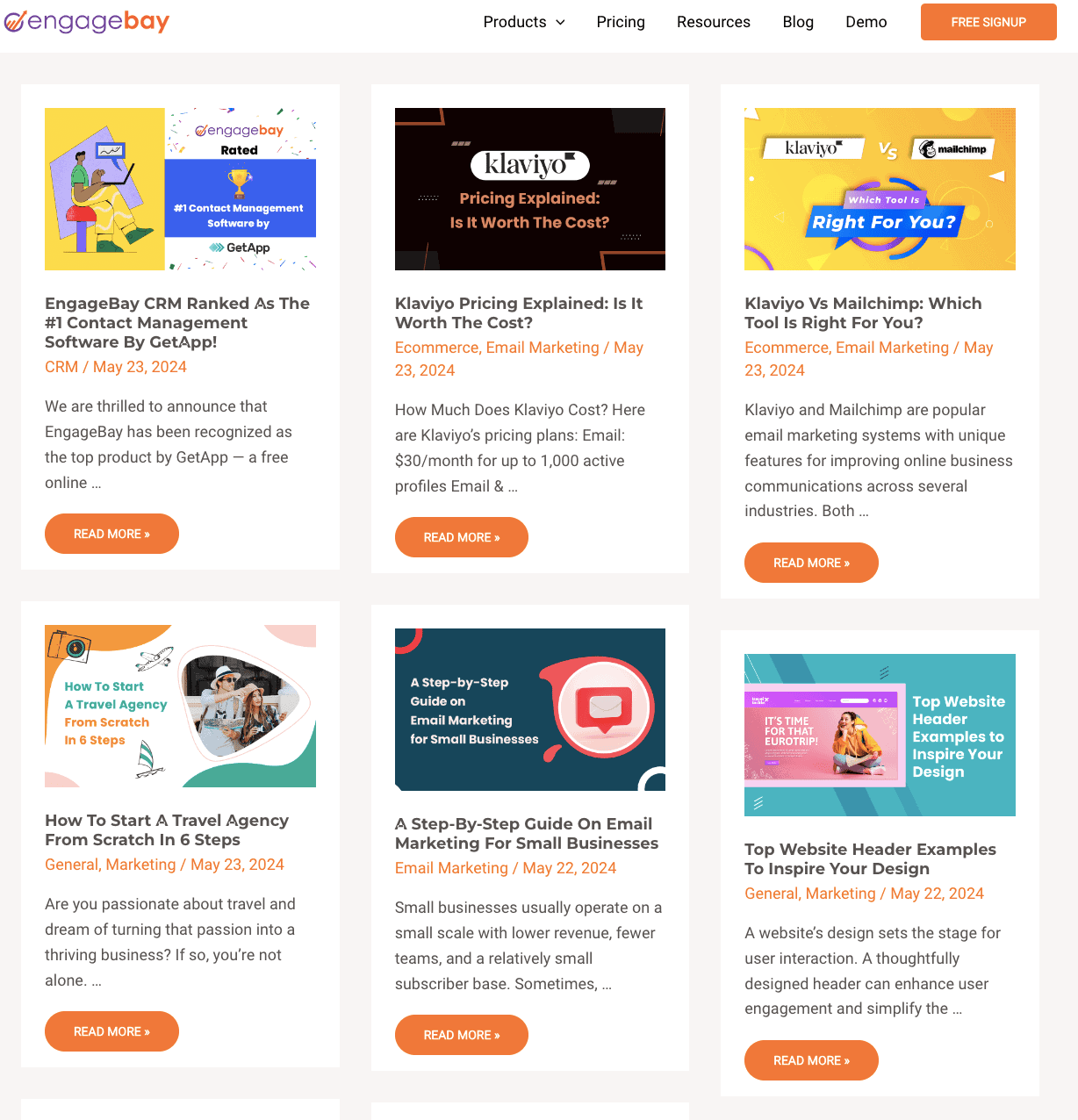
Then, you need to come up with a new content plan and a content calendar. In the content plan, be specific about the kind of content assets you will use for each marketing tactic.
3. SEO and website optimization
The next step is to ensure that all your content is updated with Search Engine Optimization (SEO) tactics. This means making sure you’re using the right keywords and meta descriptions to ensure a higher ranking on the Search Engine Results Page (SERP).
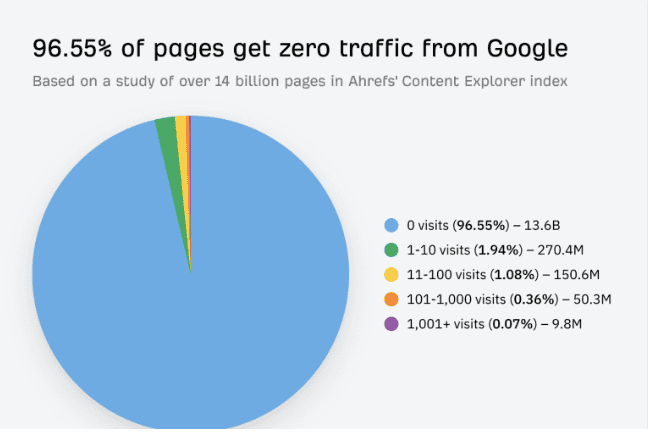
The stat above shows how important SEO can be. But this doesn’t mean you stuff your content with keywords either! After all, nothing can beat quality content that genuinely adds value to customers. So, it’s about finding the right balance.
You also need to ensure that your prospects have a smooth User Experience (UX) whenever they visit your website or open an email. This is your opportunity to create an excellent first impression, so you skip these steps at your peril!
Once these steps are done, you are ready to create excellent content and distribute it smoothly across all inbound marketing channels.
4. Lead generation and lead nurturing strategy
Once your content is ready, the next step is creating an effective lead generation strategy. When the prospect lands on your website, do you have clear Call-to-Action (CTA) buttons to help them take action?
Here, landing page design plays a crucial role. Also, ensure that you have content assets like whitepapers, templates, ebooks, or introductory offers to generate more leads and incite them to give you their contact details.
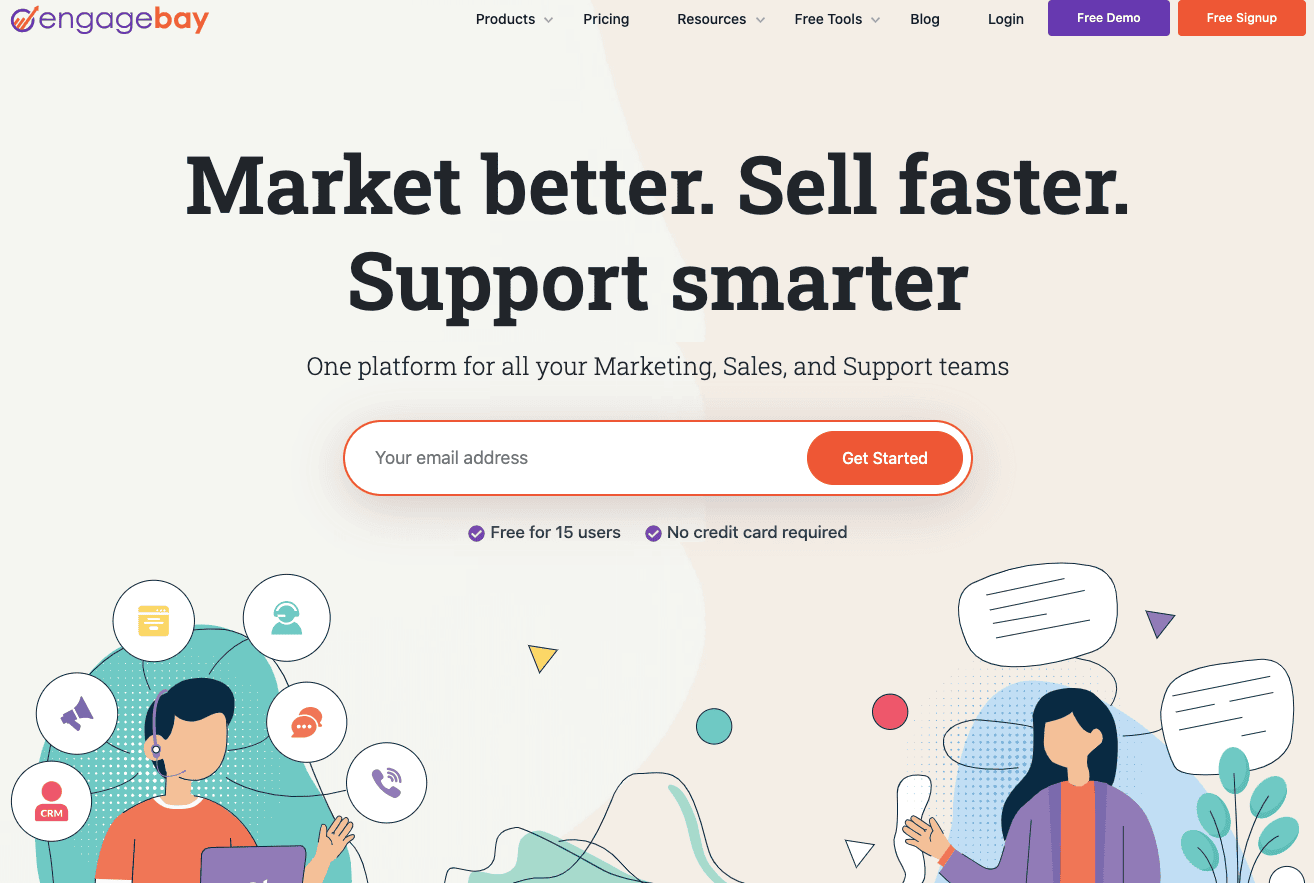
Once you generate new leads, it won’t be effective without a proper lead nurturing strategy in place. Typically, companies nurture their leads with a well-timed email campaign starting with a welcome email. Here’s an example from Adobe:
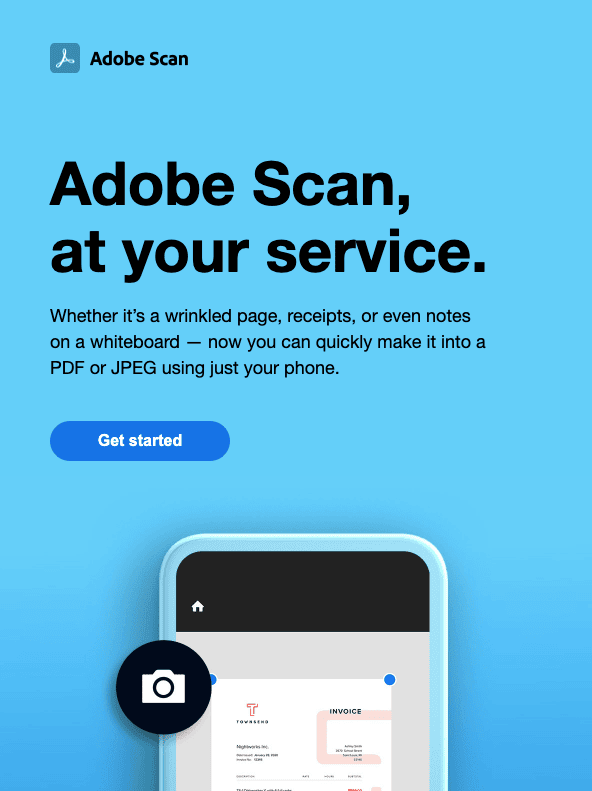
Your lead nurturing strategy should also include personalized content based on your buyer personas and valuable content targeting their pain points so that you retain their interest and start building a trusted relationship with prospects.
5. Monitor the KPIs and constantly improve your process
The final step is regularly measuring your key metrics and inbound marketing KPIs. An effective CRM like EngageBay or an analytics tool will greatly help with this step.
Based on your data, constantly innovate and tweak your existing inbound marketing strategy to align with your goals.
Finally, don’t forget to stay updated with the latest inbound marketing trends. Keep an eye on your competitor’s strategies as well.
Read more: Inbound Marketing Guide — Definition, Stages, and Strategy
A Winning Inbound Strategy Aligns With Overall Business Goals
Aligning with your overall business goals is crucial for the best results and seamless integration of your inbound marketing strategy. This is one of many companies’ key weaknesses, and trust us, you don’t want to be one of them.

The key element is to implement integrative strategies. Let’s say your goal is to increase your yearly sales revenue target by 25%. In this case, you could come up with a breakdown of a marketing plan like this:
- The marketing goal is to increase organic website traffic by 30% by mid-year and SQLs (Sales Qualified Leads) by 6% by mid-year. Depending on how well your sales team can close these deals, this will contribute to the overall sales goal.
- You can now outline a content strategy for offering new freebies like whitepapers, e-books, or templates to achieve these goals.
- Then, optimize your website with the right CTA buttons and UX design. Have a clear strategy to nurture these new leads as well.
- Finally, break down your overall marketing goals into monthly SMART goals and start creating your content as soon as possible.
- Hire experts to create content or for UX design if your team isn’t strong with that. It would save money over hiring a marketing consultant, especially for small businesses.
Creating the Right Content and Maintaining Quality
Here are some tips to maintain quality and keep adding value to customers in the long run.
- Keep it human: Nobody likes a know-it-all, whether it’s a person or the content you produce. Write about topics that consider your customers’ pain points and add a healthy dose of empathy in each article. Your openness is what will keep prospects comfortable and engaged.
- Hire the right team: The team behind your content plays a crucial role. Look for creatives who enjoy brainstorming ideas and constantly seek to innovate and learn from each other.
- Implement guidelines, checklists, and a clear review process: This forms one of the key quality checks. Having a clear set of guidelines, in-house style guides, and content checklists will ensure that your writers have a solid foundation on which to build. This creates a positive feedback loop where your writers improve their work and standards over time.
- Create a content-quality mission statement: Summarize your content objectives in one sentence. This serves as a cornerstone for your team’s daily reference. For example, “To create engaging content that provides creative and relevant solutions to prospects’ pain points.”
- Right analytics and staying on top of trends: The right analytics tools like EngageBay will help you consistently monitor the right KPIs to evaluate the effectiveness of your content strategy. You can immediately re-work strategies if they’re not panning out as intended. Always stay on top of marketing trends, innovate, and update your content strategy.
Conclusion
The digital marketing landscape today is evolving rapidly. Whether it’s the increased use of AI and automation or the meteoric rise of video content, one thing remains clear: No company can afford to skip implementing an inbound marketing strategy to stay relevant.
The silver lining is that businesses of all sizes can now leverage the power of inbound marketing to foster a genuine relationship with their audience. It’s a real, human, and meaningful way to build a base of loyal customers.
You’ll stay top of mind in the ever-evolving digital marketing space, constantly impress audiences, and meet their changing demands! We hope our inbound marketing success stories inspired you to get started today.
Let us know in the comments which success story stood out to you!
FAQ
What is the difference between inbound marketing and outbound marketing?
Inbound and outbound marketing are two distinct ways to reach new customers and boost engagement. While inbound marketing focuses more on providing value and building relationships, outbound marketing relies on pushing messages to a large audience with less focus on long-term customer relationships. Here are the key differences.
| Aspects | Inbound Marketing | Outbound Marketing |
| Audience | Focused approach to attracting and engaging interested prospects | Targets a broader audience regardless of interest |
| Communication style | Fosters two-way communication and encourages interaction | Often viewed as intrusive, lack of interaction |
| Content style | Content-driven focused on adding value through content | Promotional or advertising-focused content |
| Permissions | Relies on opt-ins and permission-based approach to delivering content | May use interruption-based methods at times, without explicit content |
| Priority | Prioritizes long-term relationship building with prospects | Prioritizes immediate sales goals |
| Search ranking | Mainly includes organic search rankings | Includes paid search rankings as well |
| Uses | Used to increase brand visibility and credibility | Used to highlight new products or services to an unfamiliar audience. |
How long does it take to see results from inbound marketing?
For most companies, irrespective of size, inbound marketing takes more than a week or two to showcase significant results. If you’re just creating content like blogs, case studies, or white papers, then it would take 6-12 months to measure significant results.
Remember, your inbound marketing results depend greatly on the strategies, tactics, and tools you have used.
Can small businesses afford an effective inbound marketing strategy?
Yes, small businesses can afford an effective inbound marketing strategy. In fact, according to recent surveys, after five months of consistent investment in inbound marketing strategy, inbound leads are 80% less expensive when compared to outbound leads!
And, if you’re unsure whether you can get all the work done in-house, a simple and cost-effective way is to delegate some work to hired experts rather than hiring a marketing strategist.
This way, you can create excellent content with your team and delegate tasks like graphic design or blog writing to experts.
How do I measure the success of my inbound marketing efforts?
You must regularly measure the success of inbound marketing efforts. Some of the key metrics to help you are:
- Organic website traffic
- Conversion rates
- Cost-per-lead
- Cost-per-sale
- Email metrics
- Click-through-rates
Is inbound marketing effective for all types of businesses?
Whether you’re a small business or a larger enterprise, inbound marketing is a sure way to establish yourself as a credible thought leader in a field with so much competition. Inbound marketing helps businesses of all sizes to develop trust, improve online visibility, retain customers, and generate new leads.
How can I keep up with changes in inbound marketing trends and technologies?
Here are some ways to regularly keep up with the latest trends and technologies in inbound marketing.
- Subscribe to competitor’s newsletters and inbound marketing newsletters.
- Regularly consult reputed publications in the inbound marketing field.
- Engage with multimedia content like podcasts, videos, courses, and latest books.
- Follow and engage with some popular influencers in the field of inbound marketing.
- Set a schedule to follow up with your team on the latest trends and review your technology.
- Attend digital marketing conferences and events in your area or online.
- Collaborate with inbound marketing experts and industry leaders in your area.
- Cultivate an open office environment where your team can regularly pitch new ideas and technology suggestions for inbound marketing.
